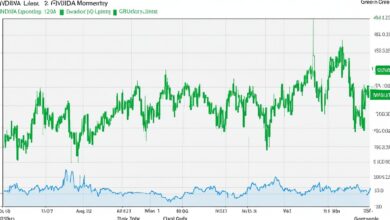Newest Trends in Options Trading: 5 Surprising Developments

Overview of the 5 Newest Trends in Options Trading
- Retail Participation in Options Trading
- Short-Dated Options: A Key Focus for Retail Traders
- Concentration of Trading Volume and Symbol Selection
- Utilizing Technical Indicators for Enhanced Options Trading Strategies
- Impact of Short-Dated Options on Retail Trading Strategies
Exploring these trends will help you adapt your trading strategies effectively. One important aspect to keep in mind is the prevalence of broker scams in the options trading industry. To ensure the safety of your investments, it’s essential to understand the true nature of these scams and learn how to protect yourself from them.
Another significant trend worth noting is the increasing popularity of short-dated options among retail traders. These options offer unique advantages and have become a key focus for many investors in recent times.
Additionally, there has been a noticeable decrease in implied volatility across various markets. Understanding the consequences of this decrease on your investment portfolio is crucial. It’s important to explore strategies that can help manage risks and maximize returns in such a volatile market environment.
By staying informed about these trends and leveraging the insights gained, you will be better equipped to navigate the evolving landscape of options trading successfully.
1. Retail Participation in Options Trading
Retail investors are now playing a significant role in options trading, making up a large portion of the market. There are several reasons behind this increase in interest:
1.1. Rise of Retail Options Trading in the Equity Market
User-Friendly Trading Platforms
Trading platforms like Robinhood and E*TRADE have made options trading more accessible to retail investors. These platforms are easy to use and often don’t charge any fees for trades, making it convenient for individuals to get involved.
Abundance of Educational Resources
Online resources such as YouTube tutorials and forums like Reddit’s r/options have empowered retail traders with knowledge that was previously only available to professionals.
Influence of the Pandemic
The COVID-19 pandemic prompted many people to explore new financial opportunities while being stuck at home, leading to a significant increase in retail trading activity.
Market makers play a crucial role in facilitating these trades by constantly buying and selling options contracts, ensuring that there’s always someone on the other side of the trade. This liquidity is important for keeping the market stable and allowing retail traders to execute their transactions quickly.
1.2. Examining Volume Concentration in Retail Options Activity
One interesting trend in retail options trading is the high volume of trades focused on certain popular stocks. Retail investors tend to be drawn to well-known companies like Tesla (TSLA) and Apple (AAPL), resulting in a large number of trades involving these stocks.
This concentration has an impact on both liquidity and volatility:
- Liquidity: The high volume of trades in popular stocks means that there are plenty of buyers and sellers available, which can lead to narrower differences between buying and selling prices.
- Volatility: Concentrated trading can also make stock prices more volatile, especially when there are large amounts of options contracts being traded.
The surge in GameStop (GME) options trading at the beginning of 2021 is a prime example of how concentrated retail activity can cause extreme volatility.
1.3. Impact of Short-Dated Options on Retail Trading Strategies
Retail traders are increasingly favoring short-dated options because they are cheaper and offer higher leverage. These options have shorter expiration periods, usually lasting only a few days or weeks, and come with several benefits:
- Lower Prices: Short-term options generally have lower prices compared to those with longer durations, making them more affordable for retail traders.
- Higher Potential Returns: Short-dated options are more sensitive to price changes in the underlying asset, which means that even small price movements can result in larger profits.
However, there are also risks associated with this preference:
- Time Decay: The value of short-dated options decreases rapidly as they get closer to their expiration dates.
- Increased Volatility Risk: While there’s a chance for high returns, there’s also a higher risk of losing money quickly if the market doesn’t move in your favor.
Understanding how short-dated options work can help retail traders refine their strategies and manage risks more effectively.
For more insights on dealing with broker errors that may occur due to increased trading activity, you can check out this comprehensive guide. Additionally, having a clear understanding of options settlement can further enhance your trading strategy by providing clarity on how contracts are closed.
By examining how these trends affect the overall behavior of the market, we can gain a better understanding of how retail participation in options trading is changing.
1.2. Examining Volume Concentration in Retail Options Activity
Retail investors have been heavily trading a few popular stocks in the options market, leading to a concentration of trading volume. This trend can be understood by looking at how retail investors trade and what they prefer.
Key Factors Leading to Volume Concentration:
- Retail traders often choose to trade well-known, highly volatile stocks like Tesla, Apple, and Amazon.
- They are attracted to these stocks because they frequently make headlines and have large price movements.
- Many retail investors also prefer to trade options contracts that are priced low.
- These contracts allow them to potentially make high profits with only a small amount of money invested.
Implications of Volume Concentration:
- When there is heavy trading in certain stocks, it can lead to more liquidity and narrower spreads between buying and selling prices for options on those stocks.
- However, it also means that other stocks that are not as popular might have less liquidity and wider spreads.
- Concentrated trading volumes can increase the overall risk in those particular stocks.
- Investors need to be careful not to have too much exposure to just a few stocks in their portfolios.
Measuring Retail Trading Activity:
- Techniques like order flow analysis can help us figure out how many of the trades happening in the market are being done by retail investors.
- We can also learn about retail investor behavior and their preferred trading instruments by looking at data from brokerage firms that cater to retail clients.
Retail investors play a big role in providing liquidity in the market. Understanding this concentration of trading volume helps us see how it affects individual stocks and the overall stock market.
For more information on managing these risks, you can read about systematic vs unsystematic risk.
If you’re interested in improving your trading strategies, you can learn about momentum trading techniques that can give you an edge in the stock market.
Retail investors continue to have a significant impact on options trading, influencing how the market behaves and how strategies are developed.
1.3. Impact of Short-Dated Options on Retail Trading Strategies
Retail traders are increasingly favoring short-term expirations for options due to several reasons:
- Quick Turnarounds: Short-dated options allow retail traders to capitalize on market movements within a compressed time frame. This aligns with the increasing desire for rapid gains.
- Lower Premiums: Typically, short-dated options come with lower premiums compared to longer-term alternatives. This makes them more accessible for retail investors who may be operating with smaller capital.
- Leverage and Volatility: These instruments provide a higher leverage effect, enabling traders to amplify potential returns from small price changes in the underlying assets. The ability to harness volatility can be particularly appealing, as highlighted in this insightful analysis contrasting historical volatility with implied volatility.
These trends have significant implications for retail trading strategies:
- Increased Activity and Liquidity: A surge in short-dated options trading leads to increased market activity and liquidity. Market makers play a crucial role here, ensuring efficient execution of trades.
- Volume Concentration: With retail traders flocking to short-term options, there’s a notable concentration of trading volume in specific stocks and indices. This can create unique market dynamics and influence liquidity provision.
To gain further insights into how mathematical models aid in understanding these shifts, it is worth exploring resources related to the mathematics of options trading.
Retail participation in the equity market continues to evolve, with short-dated options becoming an integral part of modern trading strategies.
2. Short-Dated Options: A Key Focus for Retail Traders
Retail traders are increasingly interested in short-dated options because they offer opportunities to profit from market volatility. These options expire within days or weeks, allowing traders to quickly adjust their positions based on market movements.
2.1. Volatility Trading Strategies Using Short-Dated Options
Short-dated options have several advantages that make them attractive to retail traders:
- Lower Premiums: Short-dated options usually have lower upfront costs compared to longer-term options, making them more affordable for traders with limited funds.
- High Gamma: These options have high gamma, which means their value can change rapidly with even small price movements in the underlying asset. This is beneficial in a volatile market, as it allows traders to capture significant price swings.
- Flexibility in Strategy: Short-dated options offer the flexibility to use various trading strategies like straddles, strangles, and iron condors. These strategies can be customized to profit from expected volatility within a short time frame.
Here are some examples of volatility trading strategies that can be implemented using short-dated options:
- Straddle Strategy:Involves buying both a call and a put option at the same strike price and expiration date.
- Profitable if the underlying asset makes a large move in either direction.
- Strangle Strategy:Similar to a straddle but with different strike prices for the call and put options.
- Requires less initial investment and profits from significant price movements.
- Iron Condor:Combines four options (two calls and two puts) at different strike prices but the same expiration date.
- Designed to take advantage of low volatility by profiting from minimal price movement.
By exploring these strategies, retail traders can gain insights into how they can effectively navigate market volatility using short-dated options.
2.2. Contrasting Short-Dated Options with Extended-Term Alternatives
When comparing short-dated options with extended-term alternatives like Long-term Equity Anticipation Securities (LEAPS), it becomes clear that each has its own advantages and limitations.
Short-Dated Options:
- Advantages:Quick turnaround, allowing for rapid gains or losses.
- Lower capital requirement due to smaller premiums.
- Limitations:Higher risk as they are more susceptible to time decay (theta).
- Require precise timing of market entry and exit points.
Extended-Term Alternatives (LEAPS):
- Advantages:Provide more time for investments to materialize, reducing pressure from immediate market fluctuations.
- Lower sensitivity to time decay compared to short-dated options.
- Limitations:Higher premiums making them less accessible for smaller retail investors.
- Longer duration exposes traders to prolonged market risks.
Understanding these differences helps traders align their strategies with their investment goals and risk tolerance levels. It’s important to note that there is no “one-size-fits-all” approach, and the choice between short-dated options and extended-term alternatives will depend on individual preferences and market conditions.
Incorporating both short-dated and extended-term options into your trading strategy can provide a balanced approach, leveraging the benefits of each type while mitigating their respective drawbacks.
2.2. Comparing Short-Dated Options with Extended-Term Alternatives
Short-dated options and LEAPS (Long-Term Equity Anticipation Securities) represent two ends of the spectrum in the world of exchange-traded options. Each offers unique advantages and limitations that can significantly influence trading strategies.
Advantages of Short-Dated Options:
- Higher Volatility: Short-dated options are highly sensitive to price movements, making them ideal for capitalizing on short-term market volatility.
- Lower Premiums: These contracts typically have lower premiums compared to long-term alternatives, allowing retail traders to participate with smaller capital outlay.
- Frequent Trading Opportunities: With expirations ranging from weekly to even daily, traders can continuously engage in new positions without committing long-term capital.
Limitations of Short-Dated Options:
- Time Decay: The value of short-dated options erodes quickly due to time decay, requiring precise timing and active management.
- Risk of Rapid Losses: The high sensitivity to market movements can lead to rapid losses, particularly if the market moves against the trader’s position.
In contrast, LEAPS provide a different set of benefits:
Advantages of LEAPS:
- Reduced Time Decay: LEAPS experience less time decay relative to short-dated options, offering more stability over time.
- Long-Term View: These contracts allow traders to take a long-term view on underlying assets without needing frequent adjustments.
- Hedging Benefits: LEAPS can serve as effective hedging tools for long-term investments due to their extended duration.
Limitations of LEAPS:
- Higher Premiums: The cost associated with LEAPS is higher, reflecting their extended time horizon and reduced risk of time decay.
- Less Frequent Trading Opportunities: With expirations spanning years rather than days or weeks, LEAPS do not offer the same frequency of trading opportunities.
Retail traders often prefer short-dated options because they are inexpensive and have the potential for quick profits. However, for those looking to diversify their strategies or hedge long-term investments, exploring resources on neutral options strategies can provide valuable insights beyond short-dated options.
Understanding these distinctions allows you to tailor your approach based on market conditions and individual risk tolerance. For instance, if you’re seeking technical analysis insights that could enhance your strategic decisions, consider mastering tools like the RSI indicator which can give you a significant edge in the market.
3. Concentration of Trading Volume and Symbol Selection
Retail options trading has seen a significant concentration of trading volume in a few popular symbols. This is because retail traders tend to focus on well-known, high-volume stocks, often influenced by media coverage and social media trends. This concentration has two main implications:
- Limited Portfolio Diversification: Retail traders’ narrow focus on a few symbols can lead to portfolios that lack diversification. This approach increases the risk since the performance of a small number of stocks heavily impacts overall portfolio returns.
- Market Imbalance: High trading volumes in these popular symbols can result in increased volatility, affecting price stability.
3.1 Exploring the Role of ETFs (Exchange-Traded Funds) in Options Volume Concentration
ETFs have become significant players in the options market for several reasons:
- Diversification Benefits: ETFs offer exposure to a group of securities, allowing retail traders to diversify their portfolios without having to pick individual stocks.
- Liquidity: Popular ETFs tend to have high liquidity, making it easier for traders to enter and exit positions without causing significant price changes.
The concentration of trading volume in ETFs reflects their versatility in accommodating various trading strategies, including hedging and speculative plays.
To gain further insights into changes in options trading over the years, you may find How Options Trading Changed In The Last Decades particularly informative.
When choosing symbols to trade, retail traders should consider how it fits into their overall strategy. By diversifying beyond just a few popular symbols and incorporating ETFs, they can reduce risks associated with concentrated volume. Analyzing retail trading patterns helps us understand market dynamics better and develop more balanced approaches to options trading.
Understanding the differences between short-dated and long-term options is also crucial. In this aspect, comparing different broker types for options trading can be helpful. It allows traders to find the best fit for their trading goals, improving their ability to navigate the complexities of retail options trading.
Additionally, for a comprehensive understanding of financial terms, it is worth exploring what it means to exercise an option. This exploration will explain how this concept affects your everyday life and its importance in the world of finance.
Finally, for those interested in making well-informed financial decisions, a comparison between FX Spot vs FX Options Trading can provide valuable insights. This analysis is particularly relevant for skilled traders in the US looking to optimize their trading strategies.
4. Using Technical Indicators for Better Options Trading Strategies
Options trading benefits greatly from using technical indicators. These tools help traders make smart decisions by studying market trends and identifying potential entry and exit points. Some popular technical indicators include:
- RSI (Relative Strength Index): Measures the speed and change of price movements to identify overbought or oversold conditions.
- Bollinger Bands: Shows volatility and potential price breakouts through visual representation.
- Intraday Momentum Index (IMI): Combines elements of RSI with intraday data, useful for day traders focusing on options.
- Money Flow Index (MFI): An oscillator that uses both price and volume to predict reversals.
- Put-Call Ratio: A sentiment indicator comparing the trading volume of put options to call options.
- Open Interest: Reflects the total number of outstanding option contracts, indicating market strength or potential reversals.
What Retail Traders Should Keep in Mind When Using Technical Indicators in Options Analysis
When using these indicators, retail traders should remember:
- Market Context: Understanding broader market trends helps in interpreting indicator signals accurately.
- Indicator Combinations: Using multiple indicators together can provide a more comprehensive analysis.
- Risk Management: Technical indicators should be used alongside sound risk management practices to mitigate potential losses.
For more advanced strategies, it can be helpful to explore concepts like Option Moneyness. Option moneyness is an important aspect to understand as it explains the key concepts and advanced strategies for maximizing profits in the US market.
In addition, mastering techniques such as Rolling Options can elevate your trading strategies, maximizing profits through strategic adjustments. Rolling options is a skill that allows you to make strategic changes to your positions, unlocking the potential to maximize profits and take your trading strategies to new heights.
By incorporating these technical indicators into your trading toolkit, along with understanding option moneyness and mastering rolling options, you can improve your strategy, making more accurate and confident trades in the dynamic world of options trading.
Conclusion
Options trading is always changing, and it’s important to keep up with the latest trends in order to succeed. One of the biggest changes we’ve seen recently is the growing number of individual traders getting involved. To do well in this new environment, you need to be able to adapt and take advantage of these changes.
One area that many retail traders are focusing on is short-term options. These types of options have some unique benefits when it comes to trading volatility and can be a great way to profit from quick market moves. But they also have their limitations, so it’s important to understand how they compare to longer-term options like LEAPS.
Another thing we’ve noticed is that a small number of stocks and ETFs tend to dominate trading volume. This means that if you’re not careful, your portfolio could end up being too concentrated in just a few positions. So it’s important to pay attention to which symbols you’re trading and make sure you have enough diversification.
When it comes to analyzing the market and making trades, technical indicators are still incredibly useful tools. They can help you spot potential opportunities and risks, making your decisions more informed. So if you haven’t already, consider incorporating some of these indicators into your own trading strategy.
Resources for Further Learning
If you’re interested in learning more about options exchanges or want some guidance on choosing between call and put options, here are a couple of resources that might be helpful:
- Options Exchanges: Who They Are And How They Operate: This article provides an in-depth look at different options exchanges and how they function.
- Call vs Put: The Ultimate Showdown in Options Trading: If you’re new to options trading or just want a refresher on the basics, this guide breaks down the differences between call and put options and can help you figure out which strategy aligns best with your investment goals.
Remember, the world of options trading is always changing. It’s important to keep learning and be open to trying new strategies if you want to stay ahead.







